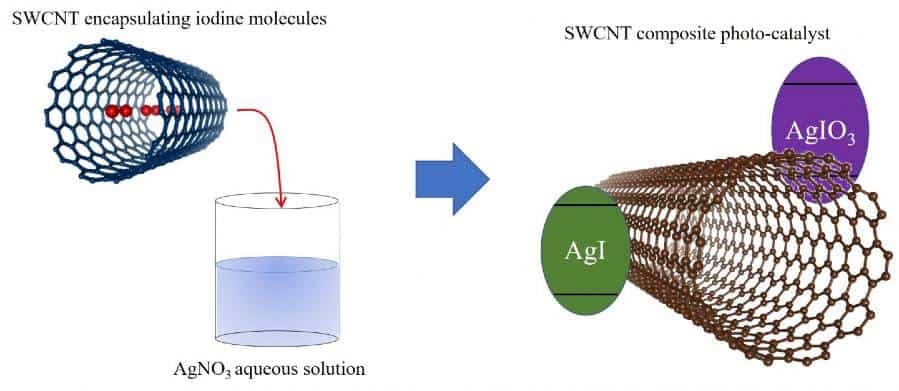Carbon dioxide (CO2) emissions from human activities have risen drastically over the last century and a half and are seen as the primary cause of global warming and abnormal weather patterns. So, there has been considerable research focus, in a number of fields, on lowering our CO2 emissions and its atmospheric levels. One promising strategy is to chemically break down, or ‘reduce,’ CO2 using photocatalysts–compounds that absorb light energy and provide it to reactions, speeding them up. With this strategy, the solar powered reduction of CO2, where no other artificial source of energy is used, becomes possible, opening doors to a sustainable path to a sustainable future.
A team of scientists led by Drs. Shinji Kawasaki and Yosuke Ishii from Nagoya Institute of Technology, Japan, has been at the forefront of efforts to achieve efficient solar-energy-assisted CO2 reduction. Their recent breakthrough is published in Nature’s Scientific Reports![]() .
.
Their research began with the need to solve the limited applicability problem of silver iodate (AgIO3), a photocatalyst that has attracted considerable attention for being useful for the CO2 reduction reaction. The problem is that AgIO3 needs much higher energy than that which visible light can provide to function as an efficient photocatalyst; and visible light is the majority of solar radiation.
Scientists have attempted to work around this efficiency problem by combining AgIO3 with silver iodide (AgI), which can efficiently absorb and utilize visible light. However, AgIO3-AgI composites have complicated synthesis processes, making their large-scale manufacturing impractical. Further, they don’t have structures that offer efficient pathways for the transfer of photoexcited electrons (electrons energized by light absorption) from AgI to AgIO3, which is key to the composite’s catalytic activity.
“We have now developed a new photocatalyst that incorporates single-walled carbon nanotubes (SWCNTs) with AgIO3 and AgI to form a three-component composite catalyst,” says Dr. Kawasaki, “The role of the SWCNTs is multimodal. It solves both the synthesis and the electron transfer pathway problems.”
The three-component composite’s synthesis process is simple and involves just two steps: 1. Encapsulating iodine molecules within the SWCNT using an electrochemical oxidation method; and 2. Preparing the composite by immersing the resultant of the previous step in an aqueous solution of silver nitrate (AgNO3).
Spectroscopic observations using the composite showed that during the synthesis process, the encapsulated iodine molecules received charge from the SWCNT and converted into specific ions. These then reacted with AgNO3 to form AgI and AgIO3 microcrystals, which, due to the initial positions of the encapsulated iodine molecules, were deposited on all the SWCNTs uniformly. Experimental analysis with simulated solar light revealed that the SWCNTs also acted as the conductive pathway through which photoexcited electrons moved from AgI to AgIO3, enabling the efficient reduction of CO2 to carbon monoxide (CO).
The incorporation of SWCNTs also allowed for the composite dispersion to be easily spray-coated on a thin film polymer to yield flexible photocatalytic electrodes that are versatile and can be used in various applications.
Dr. Ishii is hopeful about their photocatalyst’s potential. “It can make the solar reduction of industrial CO2 emissions and atmospheric CO2 an easy-to-scale and sustainable renewable energy-based solution tackling global warming and climate change, making people’s lives safer and healthier,” he says.
The next step, the team says, is to explore the possibility of using their photocatalyst for solar hydrogen generation. Perhaps, humanity’s future is bright after all!

Fig. 1: Synthesis method for the novel three-component photocatalyst
A carbon nanotube encapsulating iodine molecules is immersed in silver nitrate (AgNO3) aqueous solution to produce the composite photocatalyst.
Image courtesy: Shinji Kawasaki and Yosuke Ishii from Nagoya Institute of Technology

Fig. 2: Mechanism of the novel three-component photocatalyst
The photoexcited electron from silver iodide (AgI) travels along the carbon nanotube to silver iodate (AgIO3) where carbon dioxide (CO2) is reduced to carbon monoxide (CO).
Image courtesy: Shinji Kawasaki and Yosuke Ishii from Nagoya Institute of Technology

Fig. 3: A flexible polymer electrode of the photocatalyst
The dispersion of the novel three-component photocatalyst can easily be spray-coated onto polymer films to produce flexible electrodes that can be integrated into numerous settings.
Image courtesy: Shinji Kawasaki and Yosuke Ishii from Nagoya Institute of Technology
Reference
| Title of original paper | One-step synthesis of visible light CO2 reduction photocatalyst from carbon nanotubes encapsulating iodine molecules |
| Journal | Scientific Reports |
| DOI | 10.1038/s41598-021-89706-2 |
About Professor Shinji Kawasaki and Assistant Professor Yosuke Ishii
Dr. Shinji Kawasaki is a Professor of the Department of Life Science and Applied Chemistry at Nagoya Institute of Technology, Japan. His research interests include the use of nanocarbon and nanocarbon composites for various applications, such as energy storage, hydrogen generation, chemical modification, carbon nanotube synthesis, lighting devices, and graphene synthesis. To date, he has 107 publications to his name.
Dr. Yosuke Ishii is an Assistant Professor at the Department of Life Science and Applied Chemistry at Nagoya Institute of Technology, Japan. He obtained his Ph.D. from Nagoya Institute of Technology in 2014. To date, he has 43 publications to his name.
Funding information
This study was partly supported by JSPS KAKENHI (Grant numbers 17K14543, 19K15502, 19H02809 and 20K20946), the Takahashi Industrial and Economic Research Foundation, the Hibi Science Foundation, and the Society of Iodine Science.


